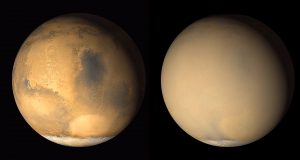Every now and then, Mars experiences gusty dust storms that stretch throughout the planet. After reviewing the data collected by NASA Mars Reconnaissance Orbiter (MRO), it was discussed that it could be one of the reasons which are contributing to the loss of gas from the planet’s atmosphere. The most recent global dust storm happened on Mars back in 2007.
Ages ago, Mars was a warmer, damper planet. Over centuries, it changed as the gases escaped Mars’ atmosphere, which further resulted in the planet becoming frozen, as we know it today.
Using the Mars Express Orbiter of European Space Agency, and Hubble Space Telescope of NASA, a link has been found between water vapor in the planet’s middle atmosphere and the loss of hydrogen from the top of the atmosphere in the past few years. This study, published in Nature Astronomy, reports a connection between higher levels of water vapor in Mars’ middle atmosphere and dust storms.
Researchers told that water gets carried to the upper layers because of a rising air mass that occurs during the dust storms.
However, the observations of middle atmosphere water vapor and gas escape were done after the 2007 dust storm, in the years of relative calm. This is why 2018 will turn out to be an exciting year, as a new global dust storm will begin on Mars.
This new dust storm will come with its own hindrances. Scientists say that this storm will start this summer and will continue till early 2019. This will result in potential damages and problems for the existing Mars missions. For instance, the Opportunity Rover relies on solar panels for energy, which will be hampered by the dust storm. The upcoming InSight Lander’s parameters would need to be adjusted for safe entry, descent and landing in November. Also, the cameras on these space crafts will need to adjust with low visibility.


